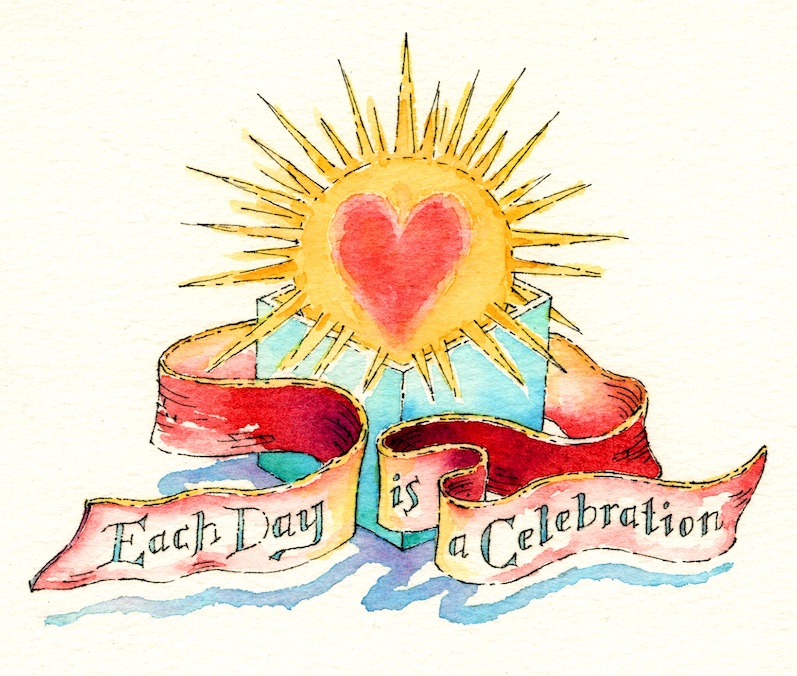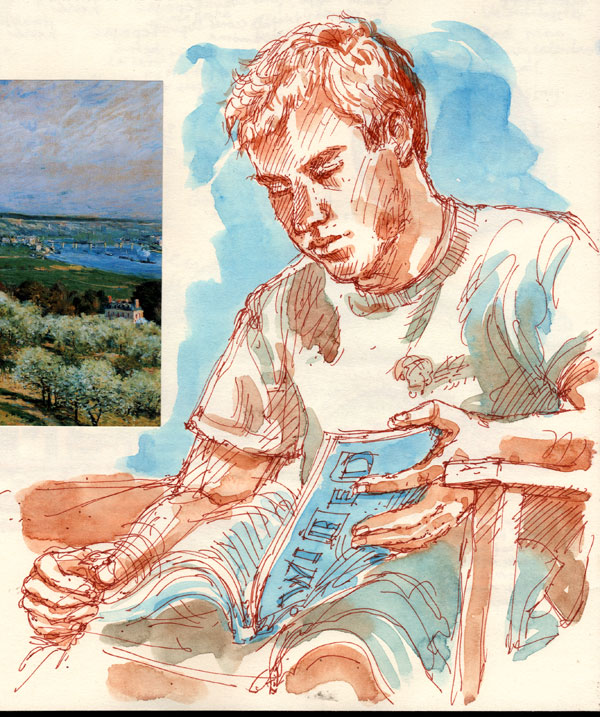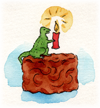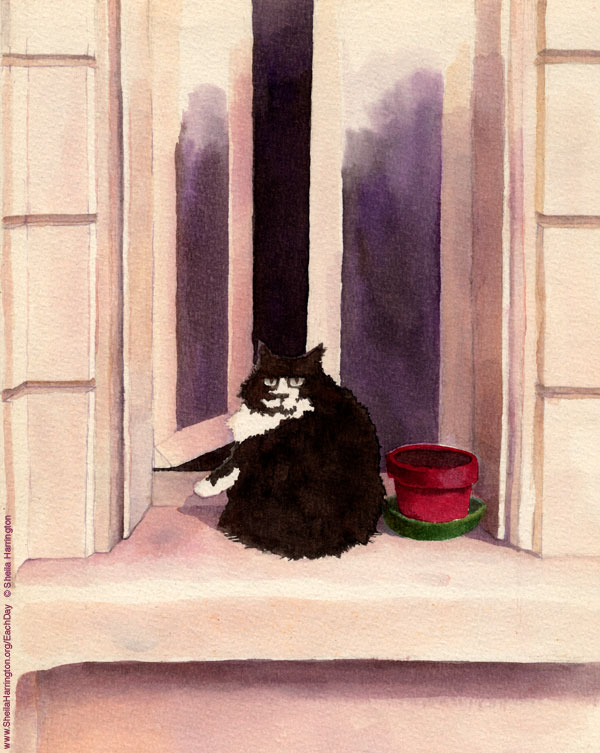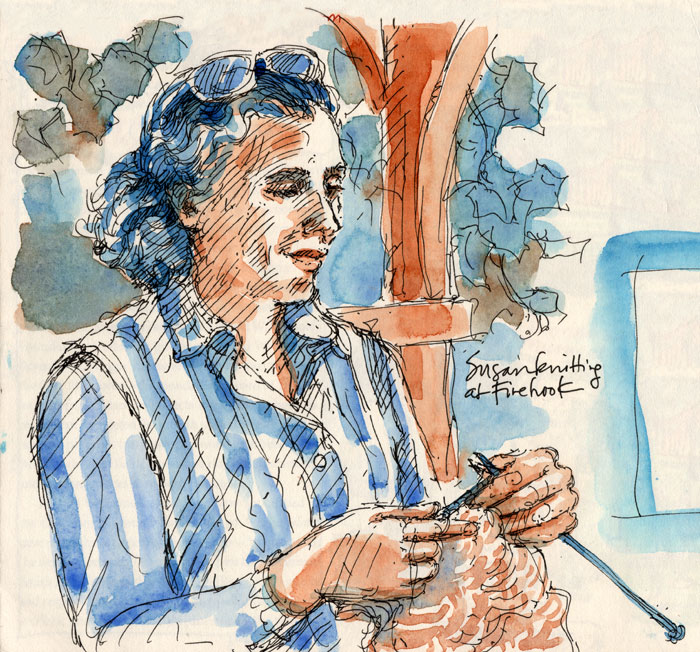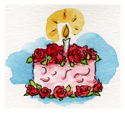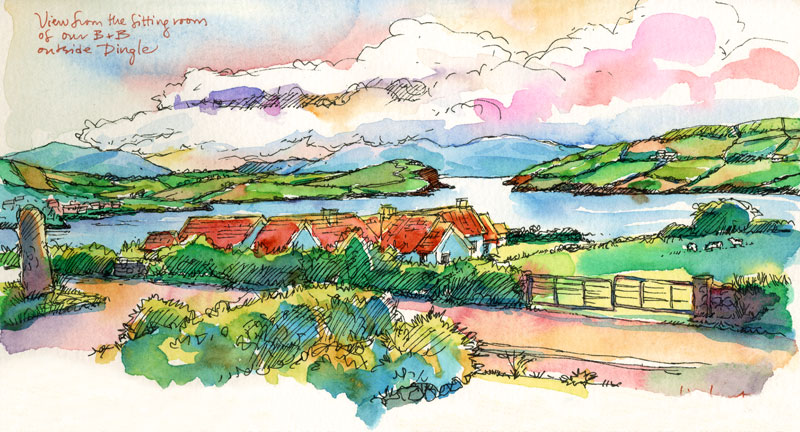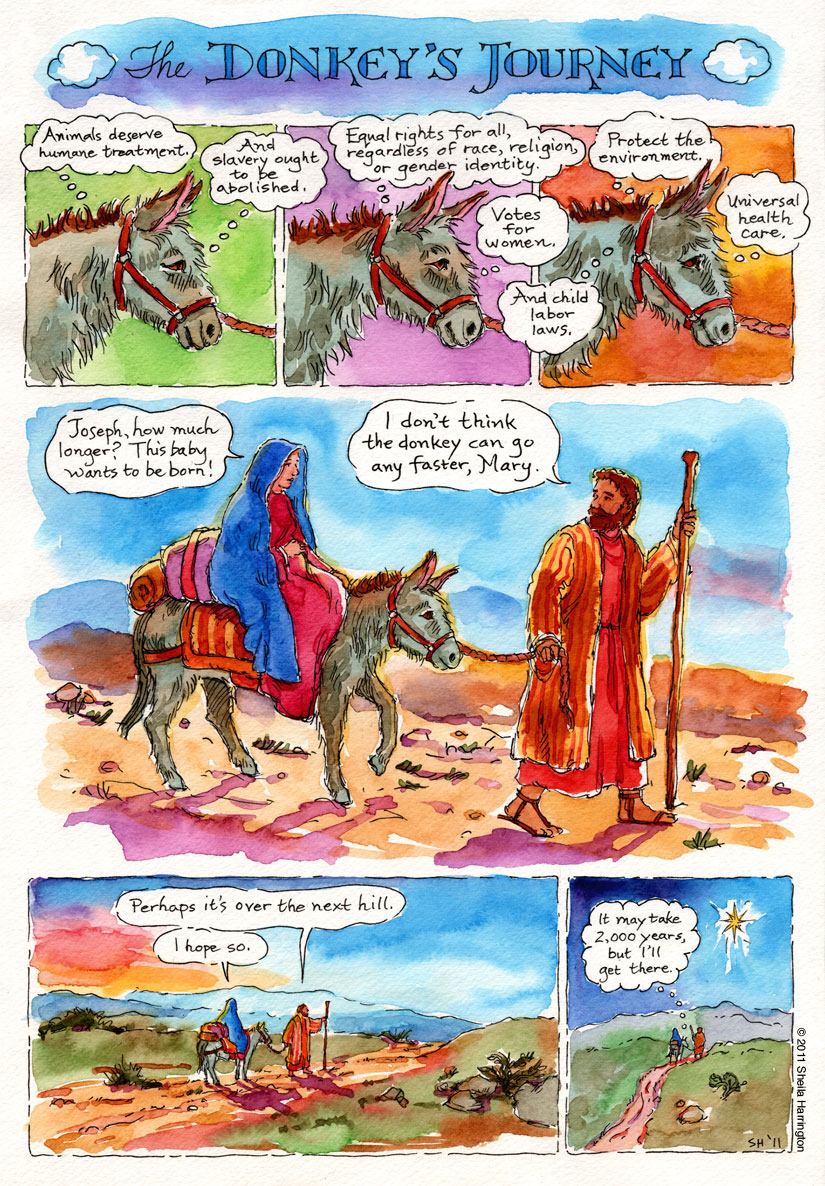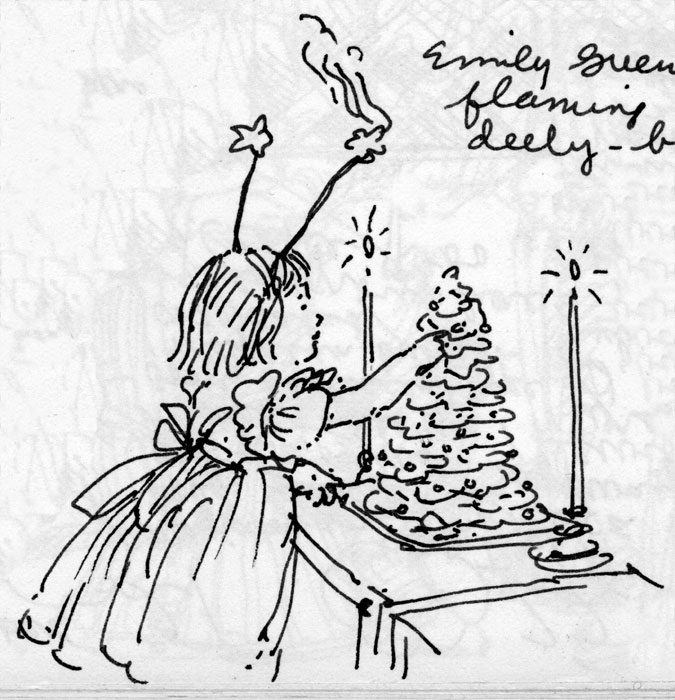Today is the birthday of Elizabeth Barrett Browning, and for a picture and a poem, please see A Love Story.
Tag: Birthday
Come Live With Me and Be My Love
Although the imagery isn’t exactly appropriate for the weather, I post this verse and accompanying painting in honor of the baptismal date (his actual birthdate is unknown) of Christopher Marlowe (1564-1593), poet, playwright, freethinker, and influential contemporary of Shakespeare. Anyway, March is just around the corner, so pretty lambs and melodious birds cannot be far off.
The combination of Marlowe’s successful career, yawning gaps in the biographical record, and early mysterious death in a tavern brawl have led to much speculation about his love life, religious views, and supposed alternate career as a government spy. I can’t think why his story hasn’t yet been made into a swashbuckling PBS mini-series.
Come live with me and be my love, And we will all the pleasures prove That valleys, groves, hills, and fields, Woods or steepy mountain yields.And we will sit upon the rocks, Seeing the shepherds feed their flocks, By shallow rivers to whose falls Melodious birds sing madrigals.
And I will make thee beds of roses And a thousand fragrant posies, A cap of flowers, and a kirtle Embroidered all with leaves of myrtle;
A gown made of the finest wool Which from our pretty lambs we pull; Fair lined slippers for the cold, With buckles of th purest gold;
A belt of straw and ivy buds, With coral clasps and amber studs: And if these pleasures may thee move, Come live with me and be my love.
The shepherds’ swains shall dance and sing For thy delight each May morning: If these delights thy mind may move, Then live with me and be my love.
—Christopher Marlowe
The painting above was created for the cover of a CD, The Sylvan Court.
The Deep River Ran On
Today is the birthday of W.H. Auden (1907-1973), and it is in his honor that I post this rather melancholy but very beautiful poem.
This day is also the 125th anniversary of the dedication in 1885 of the Washington Monument, so for an illustration and mini-history, please see Washington’s Monument.
As I walked out one evening, Walking down Bristol Street, The crowds upon the pavement Were fields of harvest wheat.And down by the brimming river I heard a lover sing Under an arch of the railway: ‘Love has no ending.
‘I’ll love you, dear, I’ll love you Till China and Africa meet, And the river jumps over the mountain And the salmon sing in the street,
‘I’ll love you till the ocean Is folded and hung up to dry And the seven stars go squawking Like geese about the sky.
‘The years shall run like rabbits, For in my arms I hold The Flower of the Ages, And the first love of the world.’
But all the clocks in the city Began to whirr and chime: ‘O let not Time deceive you, You cannot conquer Time.
‘In the burrows of the Nightmare Where Justice naked is, Time watches from the shadow And coughs when you would kiss.
‘In headaches and in worry Vaguely life leaks away, And Time will have his fancy To-morrow or to-day.
‘Into many a green valley Drifts the appalling snow; Time breaks the threaded dances And the diver’s brilliant bow.
‘O plunge your hands in water, Plunge them in up to the wrist; Stare, stare in the basin And wonder what you’ve missed.
‘The glacier knocks in the cupboard, The desert sighs in the bed, And the crack in the tea-cup opens A lane to the land of the dead.
‘Where the beggars raffle the banknotes And the Giant is enchanting to Jack, And the Lily-white Boy is a Roarer, And Jill goes down on her back.
‘O look, look in the mirror, O look in your distress: Life remains a blessing Although you cannot bless.
‘O stand, stand at the window As the tears scald and start; You shall love your crooked neighbour With your crooked heart.’
It was late, late in the evening, The lovers they were gone; The clocks had ceased their chiming, And the deep river ran on.
—W. H. Auden
Sense Of Something Coming
Here is a sketch, from a few years ago, of my son at leisure. He is now leading a busy life teaching, writing, and painting, and is gifted for all three, yet restlessly wondering what lies around the next corner. For his birthday today I post this poem. Happy Birthday, dear Devin, and take heart.
I am like a flag in the center of open space. I sense ahead the wind which is coming, and must live it through. while the things of the world still do not move: the doors still close softly, and the chimneys are full of silence, the windows do not rattle yet, and the dust still lies down.I already know the storm, and I am troubled as the sea. I leap out, and fall back, and throw myself out, and am absolutely alone in the great storm.
—Rainer Maria Rilke
Cats
This rather fierce-looking cat is Minou, the spoiled darling of the concierge, painted in our long-ago Paris days. Minou is undoubtedly long gone, but she pretty much ruled the roost while she was around. I post her portrait here, along with this poem, in honor of Eleanor Farjeon (1881-1965), whose birthday it is today. For a brief bio of the delightful Farjeon, another of her poems, and a painting, please see Morning Has Broken.
Cats sleep Anywhere, Any table, Any chair, Top of piano, Window-ledge, In the middle, On the edge, Open drawer, Empty shoe, Anybody’s Lap will do, Fitted in a Cardboard box, In the cupboard With your frocks – Anywhere! They don’t care! Cats sleep Anywhere.—Eleanor Farjeon
Magic Hands
Here is friend and neighbor Susan, whose birthday it is today, and who, in all the years I have known her, rarely appears anywhere (except perhaps the theater) without a bag containing at least one current knitting project. Over the years I’ve watched beautiful pieces flow from her talented hands, destined for family, friends, or strangers in need: scarves, hats, sweaters for all ages, socks, and blankets—including a beautiful off-to-college afghan for her daughter Sara made of leftover scraps from years of Sara’s knitted garments. Each square carried distinct memories. At a recent gathering, we discovered that most of us happened to be wearing scarves Susan had made for us.
Her knitting alone might be a sufficient lifetime achievement, but Susan is also a rich literary and artistic resource, an endlessly interested and enthusiastic traveler through the world and through life, a doting mother, a fabulous cook, and a fun, funny and generous friend and human being. Happy, happy birthday, Susan, and many more to come!
Action Jackson Part 1
Throughout the 19th century, Europe remained indisputably the center of the Western art world. By the early 20th century, however, a conjunction of circumstances led to a significant non-European artistic development.
A devastating world war, followed only a decade later by widespread economic depression, the rapid decay and displacement of antique regimes, the alarming ascent of megalomaniacs to power, the ominous signs of another imminent war—all resulted in immense disruption and the repudiation of conventions and belief systems in every facet of society, including the arts, on both sides of the Atlantic. Another result of this disturbance was the arrival on U.S. shores of emigrating European intellectuals, scientists, writers, musicians—and artists.
American artists were already actively familiar with what was happening on European easels. Some had spent time studying and working abroad. Others had attempted a departure from Old World movements to pursue more locally relevant directions based on indigenous traditions and subject matter. In the 1930s this was encouraged by WPA funding of new, large-scale public art.
If you like to think of the United States as a giant compost heap (I do), you can see that this blend of rich organic matter and seed varieties would result in some interesting hybrids. Modern American painting experiments reflected diverse influences: the flattening abstraction of Cubism, the fluid intensity of Expressionism, the subconscious/dream imagery of Surrealism, the spontaneity and iconoclasm of Dada, the scale and power of Mexican mural-painting.
But someone came along whose work simultaneously drew upon, melded, and broke the boundaries of all these, with the birth of Abstract Expressionism—a purely materialist expressive form that seems somehow appropriate for the United States, the ultimate “materialist” nation. This was Jackson Pollock (1912-1956), whose birthday it is today. (Please see Action Jackson Part 2.)
For the story of another artist born on this day, please see It’s an Oldenburg.
Call the Ewes to the Hills
Today is the birthday of poet Robert Burns (1759-1796), and if you are a lover of his poetry perhaps you may be inspired to host a Burns Supper tonight. You will have to make your own haggis from scratch, however (good luck with that), because apparently the importation of haggis to the United States remains forbidden, as are all food products made with lungs. (Mystifyingly, Spam, although of questionable provenance, can be purchased without a special license and is consumed in this country at the rate of 3.8 cans per second.) Along with sampling haggis, you may toast the poet and each other with whiskey, and when sufficiently inspired recite some of your favorite Burns poems.
In honor of Burns’ birthday I post a song (with a helpful glossary at the end) which I have sung many a time to my children as they drifted off to sleep. (You can listen to a far lovelier rendition by singer Anne Lewis here.) The sketch is from my Ireland sketchbook. For another Burns sketch, please see Move Yer Hurdies.
Ca’ the yowes to the knowes,Ca’ them where the heather grows,
Ca’ them where the burnie rows,
My bonnie dearie. Hark! the mavis’ evening sang
Sounding Clouden’s woods amang,
Then a-faulding let us gang,
My bonnie dearie. We’ll gae down by Clouden side,
Through the hazels spreading wide,
O’er the waves that sweetly glide
To the moon sae clearly. Yonder Clouden’s silent towers,
Where at moonshine midnight hours
O’er the dewy bending flowers
Fairies dance sae cheery. Ghaist nor bogle shalt thou fear;
Thou’rt to Love and Heaven sae dear,
Nocht of ill may come thee near,
My bonnie dearie. Fair and lovely as thou art,
Thou hast stown my very heart;
I can die–but canna part,
My bonnie dearie. While waters wimple to the sea;
While day blinks in the lift sae hie;
Till clay-cauld death shall blin’ my e’e,
Ye shall be my dearie.
—Robert Burns
A-faulding: Sheep-gathering Burnie: Small brook Gang: Go Knowes: Hills Mavis: Thrush Rows: Rolls Yowes: EwesMarch On
Hmm, you may be saying. Isn’t this a DECEMBER post?
But no, today is a January double anniversary. On this day in 1870, caricaturist Thomas Nast first used the donkey as a symbol for the Democratic party.
A donkey had been used decades earlier in the 1830s during the campaign of Andrew Jackson. When his political opponents labeled him a “jackass” for his stubbornness, Jackson took advantage of the insult and used the animal on his campaign posters to represent instead his unyielding tenacity of purpose.
Nast, however, in his cartoon, “A Live Jackass Kicking a Dead Lion” intended his depiction to rebuke the Democratic party for its disrespectful treatment of the recently deceased Edwin M. Stanton, Abraham Lincoln’s controversial Secretary of War. Nast went on to use the Democratic donkey in later, similarly admonishing cartoons, and the association eventually became permanent. The donkey symbol has the advantage of interpretation by the viewer as representing either 1. (if you are anti-Democratic) foolish obstinacy, or 2. (if you are pro-Democratic) humble determination.
Both the names and the respective goals of American political parties have evolved over the years. It was, after all, Republican Abraham Lincoln who authored the Emancipation Proclamation, after the newly formed Republican party split off from the slavery-supporting Whigs. But, over the last century, the Democratic donkey has become a symbol, both respected and derided, of progressive values. At times it seems the Democratic party is mired in confusion, lacking direction, and anything but resolute. But if we take the veeerry looong view, we can see, beyond party affiliation, the ultimate triumph of progressive goals.
Which brings us to our second anniversary, the birthday on January 15th of Dr. Martin Luther King, Jr. (1929-1968), whose dedication, passion, eloquence and non-violent means effected tremendous change in attitudes and legislation. King is now such a heroic cultural icon that it might even surprise some of today’s schoolchildren to learn of the bitterness and vile tactics of his enemies, the assaults and death threats directed against him and his followers, the fierce opposition to what strikes us today as self-evident fairness and justice.
With his lifelong struggle for desegregation and civil rights, his goal to end poverty and compensate descendants of slaves, his protest against United States support of Latin American dictators, his encouragement to redirect government funds from the Vietnam War toward healing of social ills, he was clearly a man way ahead of many of his small-minded fellow citizens. And in this he seemed, sadly, destined for martyrdom.
Today the Montgomery Bus Boycott, the March On Washington, and the passage of the 1964 Civil Rights Act are the stuff of history textbooks. And, thanks to the Internet and YouTube, we can celebrate Martin Luther King Day by listening to King’s “I Have a Dream” speech in recognition of the progress we have made. So far.
Girl On Fire!
Today is the birthday of now-grown-up Emily, and I could not resist putting up this less than stellar sketch of her, simply because of the backstory. It was a quickie made after a big holiday party my husband and I threw years ago when Emily was almost four.
For this event, I had made a Cookie Tree of stacked largest to smallest star-shaped cookies, the whole decorated with green frosting, M&Ms, and yogurt-covered raisins. (BTW, this is a really fun holiday project if you are not already doing seven thousand other things.) Emily found the Cookie Tree irresistible and, unbeknownst to anyone, was diligently removing and consuming the edible ornaments when her festive holiday deely-bobbers (remember deely-bobbers, anyone?) CAUGHT FIRE from a nearby candle.
Neither Emily nor anyone near her noticed, but my husband (ever the alert host even when in conversation on the opposite side of the room) saw what was happening and struggled through the noisy, chatty throng, grabbed Emily’s flaming headgear, and doused it in somebody’s apple cider. Whew! But poor Emily had to go home bereft of antennae. Happy Birthday, Emily! I hope the only flames today are on your candles.
